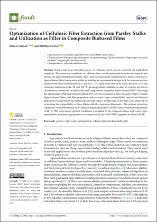| dc.contributor.author | Çakmak, Hülya | |
| dc.contributor.author | Dekker, Matthijs | |
| dc.date.accessioned | 2023-02-23T10:31:58Z | |
| dc.date.available | 2023-02-23T10:31:58Z | |
| dc.date.issued | 2022 | en_US |
| dc.identifier.citation | Cakmak, H., & Dekker, M. (2022). Optimization of Cellulosic Fiber Extraction from Parsley Stalks and Utilization as Filler in Composite Biobased Films. Foods, 11(23), 3932. | en_US |
| dc.identifier.issn | 2304-8158 | |
| dc.identifier.uri | https://doi.org/10.3390/ foods11233932 | |
| dc.identifier.uri | https://hdl.handle.net/11491/8456 | |
| dc.description.abstract | Abstract: Food waste is an abundant source of cellulose which can be extracted via mild alkali treatment. The extraction conditions of cellulose fibers can be optimized for reduced chemical and energy use and optimal functionality. This study focused on the optimization of alkali extraction of lignocellulosic fiber from parsley stalks by building an experimental design with the response surface method with alkali concentration (2, 6, and 10%, w/v), fiber:alkali ratio (0.02, 0.035, and 0.05; w/v) and extraction temperature (40, 70, and 100 ◦C) as independent variables, in order to evaluate the effects of extraction conditions on fiber yield and composition of parsley stalks extract (PSE). Following the optimization, PSE and untreated fibers (PF) were incorporated as filler into gum Arabic–sodium alginate-based films, and film properties such as water vapor permeability, optical and thermal properties, Fourier transform infrared spectra and surface morphology of the films were analyzed for evaluating the compatibility of these fillers with the composite film matrix. The optimal extraction conditions were determined as 2% alkali, sample:alkali ratio of 0.0276 and extraction temperature of 40 ◦C. PSE extracted at optimal conditions was added to the composite films, and water vapor permeability and optical properties were improved by up to 10% PSE compared to films with PF. | en_US |
| dc.language.iso | eng | en_US |
| dc.publisher | MDPI | en_US |
| dc.relation.ispartof | FOODS | en_US |
| dc.rights | info:eu-repo/semantics/openAccess | en_US |
| dc.rights | Attribution 4.0 International (CC BY 4.0) | * |
| dc.rights.uri | https://creativecommons.org/licenses/by/4.0/ | * |
| dc.subject | Parsley stalk | en_US |
| dc.subject | Waste | en_US |
| dc.subject | Optimization | en_US |
| dc.subject | Cellulose fiber | en_US |
| dc.subject | Biodegradable film | en_US |
| dc.title | Optimization of Cellulosic Fiber Extraction from Parsley Stalks and Utilization as Filler in Composite Biobased Films | en_US |
| dc.type | article | en_US |
| dc.department | Hitit Üniversitesi, Mühendislik Fakültesi, Gıda Mühendisliği Bölümü | en_US |
| dc.authorid | 0000-0002-4936-939X | en_US |
| dc.authorid | 0000-0002-0063-4252 | en_US |
| dc.identifier.volume | 11 | en_US |
| dc.identifier.issue | 23 | en_US |
| dc.relation.publicationcategory | Makale - Uluslararası Hakemli Dergi - Kurum Öğretim Elemanı | en_US |
| dc.identifier.doi | 10.3390/foods11233932 | en_US |
| dc.authorwosid | O-6862-2018 | en_US |
| dc.description.wosquality | Q1 | en_US |
| dc.description.wospublicationid | WOS:000896119000001 | en_US |
| dc.description.pubmedpublicationid | 36496740 | en_US |




















